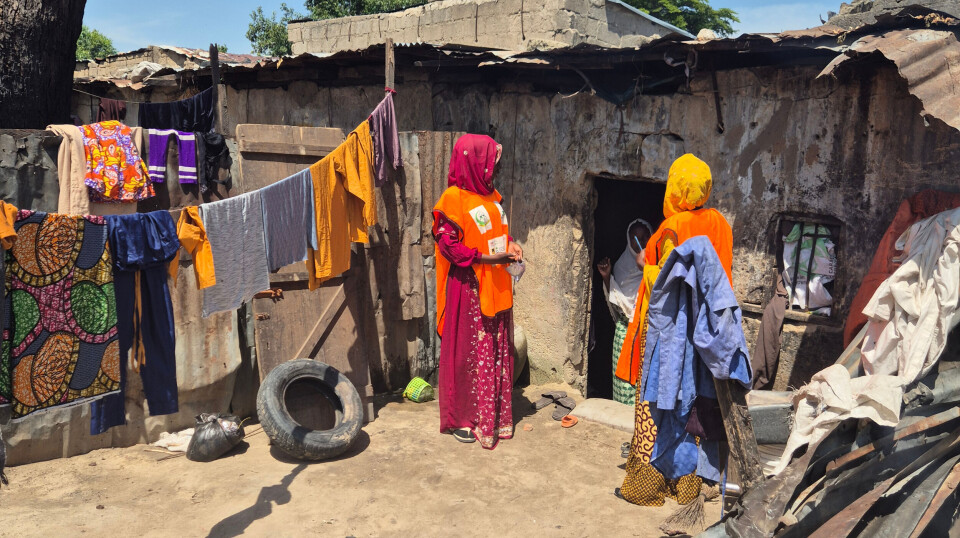THIS CONTENT IS BROUGHT TO YOU BY NUPI - Norwegian Institute of International Affairs - read more
Nigerian authorities plan to close refugee camps housing a million people
What will happen to those living there, and what could the consequences be?

Over two million people have been forced to flee their homes in north-eastern Nigeria due to over 15 years of jihadist insurgencies.
These people are classified as internally displaced persons (IDPs).
Camp closures
In Borno State, nearly one million people live in 228 refugee camps. The process of closing these camps has already begun.
“The best camps have tents provided by humanitarian organisations. In other camps, residents have built houses or huts themselves. These shelters are often the size of a small tent and accommodate six to seven people,” explains Andreas Lind Kroknes, an adviser at the Norwegian Institute of International Affairs (NUPI).
In a new report, Kroknes, NUPI researcher Morten Bøås, and researcher Mala Mustapha from the Centre for Democracy and Development (CDD) in Nigeria have conducted a foresight study to predict what may happen when the camps close.
They also provide recommendations on what needs to be done to ensure success.
“The government’s rationale is that the camps must eventually close. Authorities now believe that security conditions in Borno have improved enough for IDPs to return to their original homes,” says Kroknes.
An ambitious plan
Several jihadist insurgent groups remain active in the region, including ISIS and Jama’tu Ahlis Sunna Lidda’awati wal-Jihad, also known as Boko Haram.
The Nigerian government claims it is close to defeating Boko Haram, which has carried out numerous violent attacks over the years. Kroknes, however, believes this to be an exaggeration.
“Both the authorities and various development actors agree that the camps should close soon because they are not sustainable. People don’t have a fulfilling life there. The main argument for closing the camps is that IDPs become dependent on aid and therefore need a push to become self-reliant,” he says.
Borno State has a plan to make this work.
“The authorities in Borno plan to provide funding and resources so that people can return home or resettle elsewhere. But even with financial support from the state, the federal government, and private actors, this will be a significant challenge,” he says.
Many young people lack education
A major challenge is that many camp residents have nothing to return to.
“Many have likely spent their entire lives in the camps. Their social lives and relationships have been shaped there," says Kroknes.
He explains that educational opportunities are scarce or non-existent. When available, they mainly provide children with a mental break from camp life.
"Many parents do not see the value in sending their children to school if they can instead help with daily life in the camp,” he says.
However, the lack of theoretical knowledge is not the only challenge.
“There's an assumption that people naturally possess the skills needed to run a farm. But that’s not the case. Farming requires extensive knowledge and experience, ideally acquired from a young age. These individuals are expected to return to farms and land they do not have the skills to cultivate,” Kroknes explains.
Combined with inadequate health and education services in rural Borno, this situation creates unsafe conditions for many returning to their homes.
Some people refuse to return to their place of origin due to ongoing security concerns or past trauma.
“Many have survived attacks as the only survivors. For these individuals, what the authorities call home is a place filled with trauma,” says Kroknes.
A need for better data and planning
“This is not the first time the state has attempted what could be described as forced voluntary relocations,” Kroknes notes.
Previous efforts have led to people being displaced multiple times.
“People may return to their original homes, find that security is still insufficient, and move again. The risk of multiple displacements is high,” he says.
Several measures should be put in place to increase the chances of successful camp closures.
“Large-scale, systematic data is lacking. There have been no comprehensive labour market analyses, and little is known about the skills and backgrounds of camp residents. A traffic light system should be developed to classify areas," says Kroknes.
This system would show which areas are completely unsafe (not go to), which could be considered (pending go to), and which are ready for return (go to).
Kroknes notes that proper planning is essential to avoid worsening or prolonging the current situation.
Humanitarian organisations and authorities often disagree on the best course of action. While humanitarian groups advocate for more extensive preparations before closing camps, development actors take a more moderate stance.
“Competing claims among different actors about who is right hinder progress. They need to find common ground,” says Kroknes.
Returning to uncertainty
The researchers interviewed displaced people, government officials, and representatives from humanitarian organisations such as the Red Cross, as well as development agencies like the UN Development Programme.
“I believe many IDPs are open to leaving the camps, but they also have a realistic understanding of what is possible. No one wants to live in a camp," says Kroknes.
He explains that some representatives of authorities and development actors wrongly assume that IDPs are lazy and enjoy a comfortable existence in the camps.
"IDPs simply want to survive, and if the choice is between a high risk of death or staying in the camp, they will stay,” he says.
A life on hold
Displaced people have also expressed the need for start-up capital and tools to establish businesses.
“Entrepreneurship is a crucial part of Nigerian society, and many IDPs end up in urban areas. To make a living – whether through carpentry or furniture-making – people need start-up capital," says Kroknes.
However, there are vast differences among camp residents. Kroknes notes that some suffer from severe mental health issues that could have been addressed long ago if they had access to better healthcare facilities.
Could leaving the camps intact be a viable option?
“Not permanently. Life in the camps is not sustainable. It’s a life of waiting – a place where people wait for their lives to restart. However, this can’t end until the situation is adequately resolved. People need to feel confident that they are starting something viable, whether by returning to their farms or starting anew elsewhere,” concludes Kroknes.
Reference:
Bøås et al. The IDP situation in Borno State, Nigeria – returning to uncertainty?, NUPI report 2/2025, 2025.

This content is paid for and presented by NUPI
This content is created by NUPI's communication staff, who use this platform to communicate science and share results from research with the public. The Noprwegian Institute of International Affairs is one of more than 80 owners of ScienceNorway.no. Read more here.
More content from NUPI:
-
How Iran’s regime exploits emotions to crush protests
-
Improving the impact of the UN Peacebuilding Commission
-
Controversial calories: How do we measure hunger?
-
How Norway and the EU can collaborate in the minerals and battery sector
-
How Central Asia can help the global energy transition
-
Reduced influence in the Arctic?





































